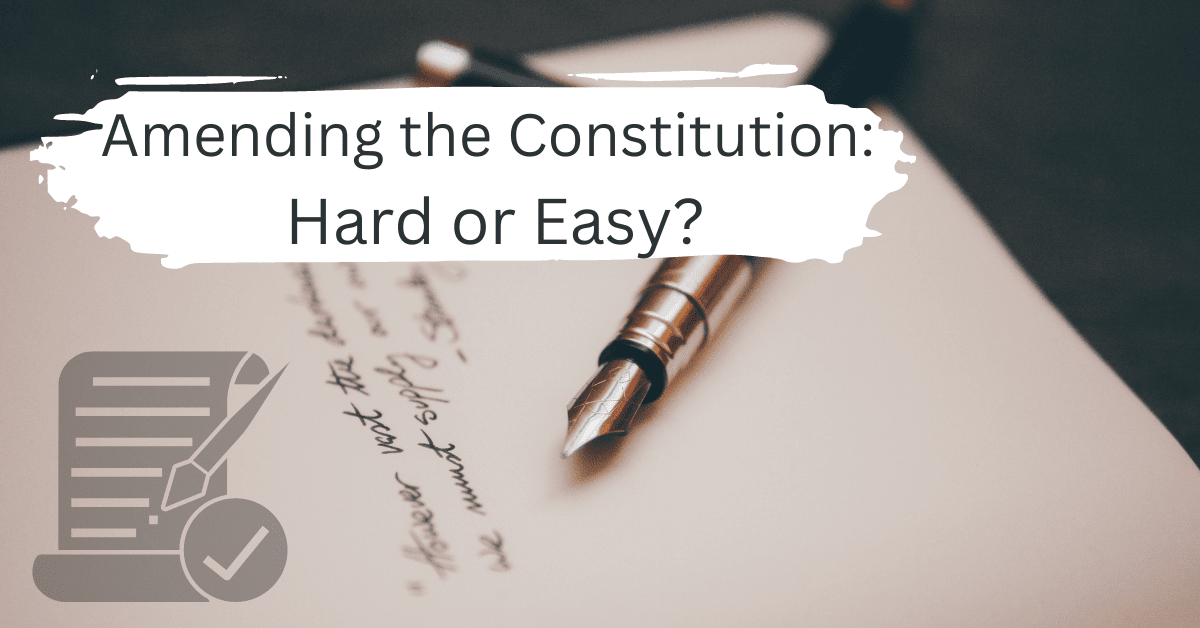Have you ever made a mistake writing a note to someone special in pen? You don’t want to scratch out your mistake. But, you also don’t want to rewrite the whole thing again. Our Founders created a process to amend our Constitution because they too made mistakes. Should the amendment process be easy or hard?
Amending the Constitution is a multi-step process requiring Congressional and state cooperation to pass an amendment. There are different voting thresholds outlined in Article 5 specifying what is needed. Each new amendment requires substantial debate to gain enough votes to pass.
The amendment process does take time. You will have to decide once you read the facts- whether it is hard or easy.
Why the Framers Make It Difficult to Change the Constitution?
General Knowledge
You’re thinking the amendment process is already difficult. That’s the reason you typed “difficult” in your internet search.
The Framers wanted the United States to last generations- not a handful of years. Why go to all the trouble of fighting the British if revolution happened again in their lifetime?
Framers made the difficulty a 7 out of 10. In other words, moderately difficult.
Below are a couple of reasons for their thought process:
1. Too easy of a process meant the Constitution changed with the sweeping tide of public opinion
2. Too difficult of a process meant Revolution
Do you see the reasons why it was evident to develop the system this way?
Also, the Framers feared future government officials. They would not make it an easy process for the sly politician.
I don’t have to remind you of your own human nature when you have little oversight without consequences. Those menacing feelings of “I can do whatever I want” pop into your head.
These are the same feelings a politician has with unlimited power. Thankfully, the Constitution tampers those emotions by providing a rigorous amendment process.
Remember, too easy and too hard are both not good. Keeping the process in the middle became the goal.
LEARN MORE about What is a Constitutional Amendment by reading my article here
Reasons For Difficulty
1. Matters of great importance should only use the amendment process
What are matters of great importance?
- Amendments restricting liberty
- Amendments reducing national security
- Amendments causing great harm to the country (broad term to encompass the unforeseen)
2. The long process provides for proper debate of the proposed amendment
You must slow the amendment process down. We can do a whole case study on Prohibition and how that was not a good idea. The only way to repeal an amendment is to pass another amendment voiding the one in question.
Passing an amendment to void another is not an efficient use of resources. The best solution to avoid that pitfall is to slow down and act with clear intent.
3. Amendments passed fast damage the intent and cohesiveness of the Constitution
Constitutional norms and precedent are present for a reason. If we are to change those norms, the changes must be valid and not damage the stability of the United States.
For instance, there is no constitutional amendment restricting the number of justices on the Supreme Court. Since 1937, we’ve had 9 justices and no political party changed the status quo.
Altering the number of spots on the Supreme Court has severe consequences. We could have 30, 40, or 50 justices depending on who controlled Congress and the Presidency.
Supreme Court Justices control what laws are declared constitutional and unconstitutional.
In other words, the Framers did not want a tit-for-tat political system. Constitutional norms, precedent, and cohesiveness rely on a slow, deliberate process without the threat of political bombardment.
Next, we will explore examples of State Constitutions with an amendment process much easier than the Federal process.
State vs. Federal Constitutions
While some of the state constitutions mirror the Federal, not all are equal when it comes to their amendment process.
You have some state constitutions amended hundreds of times. To stress my point, that’s hundreds upon hundreds of times – unlike the Federal Constitution of 27 times.
Some argue state constitutions need this easier process. They say citizens’ views are better represented.
Our Federal Constitution governs over 320,000,000 citizens. It is hard to implement change with that many people represented across an entire continent.
Both systems have positives and negatives.
Some state Constitutions allow for ballot initiative constitutional amendments. That means popular vote can add an amendment to your state constitution.
Adding ballot initiative constitutional amendments is another name for direct democracy. Remember, the Framers feared direct democracy.
Below you will find a list of all the state constitutions:
Some states have adopted different constitutions since their original and are on their 5th or 6th version of it. In the data table, the times amended and the date adopted were reset once the new version became active.
|
State |
Year Constitution Adopted |
Times Amended |
Last Amended |
|
Alabama |
1901 |
977 |
2021 |
|
Alaska |
1956 |
28 |
2004 |
|
Arizona |
1912 |
156 |
2018 |
|
Arkansas |
1874 |
102 |
2020 |
|
California |
1879 |
516 |
2020 |
|
Colorado |
1876 |
166 |
2020 |
|
Connecticut |
1965 |
32 |
2018 |
|
Delaware |
1897 |
100 |
2018 |
|
Florida |
1968 |
144 |
2020 |
|
Georgia |
1983 |
89 |
2020 |
|
Hawaii |
1959 |
269 |
2016 |
|
Idaho |
1890 |
141 |
2020 |
|
Illinois |
1970 |
14 |
2016 |
|
Indiana |
1851 |
24 |
1970 |
|
Iowa |
1857 |
48 |
2010 |
|
Kansas |
1861 |
98 |
2019 |
|
Kentucky |
1891 |
43 |
2020 |
|
Louisiana |
1975 |
203 |
2021 |
|
Maine |
1820 |
175 |
2021 |
|
Maryland |
1867 |
234 |
2020 |
|
Massachusetts |
1780 |
119 |
2000 |
|
Michigan |
1963 |
36 |
2020 |
|
Minnesota |
1857 |
120 |
2016 |
|
Mississippi |
1890 |
52 |
2020 |
|
Missouri |
1945 |
119 |
2020 |
|
Montana |
1973 |
33 |
2020 |
|
Nebraska |
1875 |
237 |
2020 |
|
Nevada |
1864 |
107 |
2020 |
|
New Hampshire |
1783 |
146 |
2018 |
|
New Jersey |
1948 |
59 |
2021 |
|
New Mexico |
1912 |
70 |
2020 |
|
New York |
1895 |
204 |
2021 |
|
North Carolina |
1971 |
42 |
2018 |
|
North Dakota |
1889 |
166 |
2018 |
|
Ohio |
1851 |
169 |
2018 |
|
Oklahoma |
1907 |
29 |
2020 |
|
Oregon |
1857 |
254 |
2020 |
|
Pennsylvania |
1968 |
49 |
2021 |
|
Rhode Island |
1986 |
5 (since 2006) |
2020 |
|
South Carolina |
1896 |
15 (since 2006) |
2014 |
|
South Dakota |
1889 |
11 (since 2006) |
2020 |
|
Tennessee |
1870 |
7 (since 2006) |
2014 |
|
Texas |
1876 |
515 |
2021 |
|
Utah |
1896 |
24 (since 2006) |
2020 |
|
Vermont |
1793 |
51 |
2010 |
|
Virginia |
1971 |
14 (since 2006) |
2020 |
|
Washington |
1889 |
109 |
2019 |
|
West Virginia |
1872 |
20 |
2018 |
|
Wisconsin |
1848 |
102 |
2020 |
|
Wyoming |
1889 |
7 (since 2006) |
2016 |
Source: Ballotpedia Charted Last Updated: Election 2020
Process Involved to Change Constitution
As a reminder, Article 5 is the part of the Constitution overseeing the amendment process. Amendments are proposed and then ratified; thus, a 2-step process.
Article 5 clearly states the duties of Congress and the basic process of changing our beloved Constitution.
While earlier state constitutions are vague about each branch’s responsibility, the Federal Constitution is clear.
Congress should not interpret the constitutional amendment process. They are not to search for roundabout ways of adding amendments. The implications of Congress deciding on its own process means no standard. Without standards, Congress is setting the constitution ablaze.
Overall Congressional Powers outlined in Article 5
1. Call a convention when summoned by 2/3 of state legislatures
Congress calls a Constitutional Convention when given the okay by 2/3 of each state legislating body. That is the only time a Constitutional Convention can be called. This is another form of state power in the congressional amendment process.
2. Propose amendments
Don’t get this confused with the above reason. Congress can propose amendments without calling a Constitutional Convention.
3. Determine the mode of ratification
Congress determines how the new proposed amendment is to be ratified
Ways to Propose Amendments

Above we just looked at the general powers the Constitution permits Congress to possess. Now, we will explore the methods to propose additional amendments.
Methods listed below:
1. Call a convention when summoned by 2/3 of state legislatures
This is how the original Constitution came to fruition- a Constitutional Convention.
How much time does Congress have to introduce a convention?
The average person says a “reasonable” amount of time. Is that 2 weeks, 2 months, 2 years, or whenever Congress wants?
Let’s just say Congress should do its job and not wait too long. If they started waiting, “We the People” need to petition our representatives to hurry the process along if it became stalled.
2. 2/3 vote of each House of Congress
In the past, no one knew what 2/3 (66%) vote of Congress meant? Is that 2/3 of Congress combined? Is that 2/3 of each House individually?
Well, it has been settled. Long-standing tradition dictates 2/3 of each House needs to vote on the potential amendment proposal.
In other words, the Senate votes, and the House of Representatives votes. Each House must have a 2/3 majority between the both of them to pass the proposal on to the states.
Ratification of Amendments
The ratification process involves the approval of amendments. If approved, they will become a roman numeral at the end of the Constitution- AN AMENDMENT!
1. Convention of States approved by ¾ of state convention representatives
When the Framers implemented this ratification method, they did not think this method would be used.
A Convention of States is a method similar to direct democracy. State voters elect representatives specifically for this convention. Once the convention is over, those representatives have no further obligation to the people.
Could you imagine campaign commercials for state conventions? I wonder how the political bashing would go.
2. ¾ of state legislatures
75% (38 states) need to vote yes to approve the amendment. Again, that is a large majority so you might consider it difficult to amend the Constitution.
On average, this process looks something like this.
Congress sends the proposed amendment to the governor. Once the governor has the amendment, they will present the amendment to the state legislature to debate and then vote yes/no. This process is not mentioned in the Constitution. But, this is how the process worked in the past.
There is one more item to ponder. State legislatures can’t be coerced by Congress to even vote on proposed amendments. They can be passive and not put the amendment up for a vote.
Many amendments die during this part of the process.
Constitutional Amendments Today?
What ideas do you have for Constitutional Amendments? Do you think that you could get your idea passed?
Here are some ideas that you’ve thought of but not necessarily verbalized:
- Congressional term limits
- Social Rights perceived by some:
- Clean Air (climate change amendment)
- Government-subsidized health care
- Free and mandatory public housing
- Repeal of the 2nd amendment
- Balanced budget
- Rights of the unborn child
The above-proposed amendments have not been added to our Constitution. Many tried to add their own flavor to these types of amendments but failed.
I’ll warn you about some of the proposed amendments listed above, and I’ll let you make your own determination. Many of the suggestions (not all) are a march to socialism in America.
French socialists lived during the Framers’ lifespans; however, their expertise did not lead us down a path of government centralization. We have a hard amendment process for a reason. You might not like it.
But, the Constitution can and has changed since the 1700s.
LEARN MORE about 6 Legendary Goals of the Preamble by reading my article here
Conclusion
In closing, we return to our original question: Is amending the Constitution hard or easy?
If you’ve read this far, I know what you will say because I will say the same. Yes, our Constitution is hard to amend. The Framers had their reasons for making it difficult to alter the most important American document.
We can’t be swept away by the tides of passion when factions gain political power. The amendment process is a methodical procedure designed to slow down adding or subtracting parts of our Constitution without debate.
If you want fast changes, look to your state constitutions. You will see way more than 27 amendments. They have hundreds.
We looked at the exact process to propose and ratify amendments. An overwhelming majority is necessary to introduce amendments for state legislatures to vote on for ratification.
There are always the newest amendments ready to gain their place at the end of “roman numeral road”. They want to become the 28, 29th, or 30 amendments.
Part of being an American is knowing your Constitution. I hope you learned a little about the amendment process.
What new amendment would you propose?
Send me a message by going to the “Let’s Talk” button
J. Liberty



